The Marangu Route, also known as the "Coca-Cola Route" or "Tourist Route", is the oldest, best established route on Mt Kilimanjaro.
Marangu is also one of the most popular routes – mainly because it is the only route on the mountain that has hut accommodation for hikers.
There are 60 bunk beds each at Mandara and Kibo Huts, and 120 bunk beds at Horombo Hut. Typically tour operators provide mattresses and pillows for climbers (sleeping bags however, need to be brought separately by trekkers).
Here's my complete guide to the Marangu route.
My Quick Takeaways:
Considering the Marangu Route for your Mount Kilimanjaro ascent? Here's a quick overview:
- Oldest and Well-Established: Known as the 'Coca-Cola Route', it's the mountain's oldest and most established path.
- Hut Accommodation: Uniquely offers dormitory-style huts with bunk beds, providing shelter from the elements.
- Shorter Duration: Typically completed in 5 to 6 days, making it one of the shorter routes to the summit.
- Gentle Gradient: Features a gradual incline, often perceived as one of the easier climbs.
- Lower Success Rate: Despite its reputation, it has a lower summit success rate, possibly due to limited acclimatisation time.
- Less Scenic Variety: The ascent and descent follow the same path, offering less diverse scenery compared to other routes.
The Marangu Route is suitable for those seeking a shorter trek with hut accommodations, but it's essential to consider the acclimatisation challenges and lower success rates associated with this path.
Ready to learn more about the Marangu Route up Kilimanjaro? Let's rock.
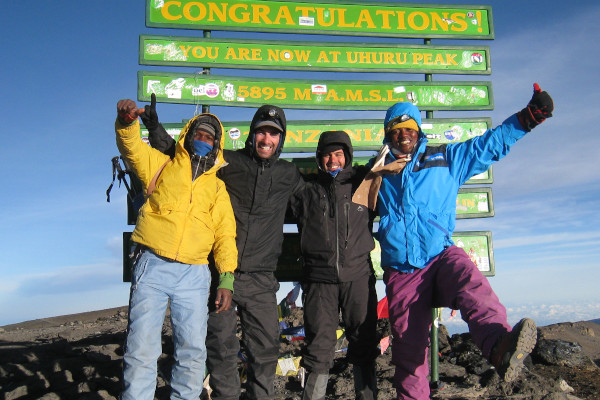
Plan your Kilimanjaro trek
Get a quote from my recommended local Kilimanjaro operator
Know Before You Go: Mt Kilimanjaro Marangu Route
The following is important to consider if you are thinking of choosing the Marangu Route for your trek.
How difficult is the Marangu Route?
Even though this is a shorter trek over relatively easy terrain, we rate the Marangu route as difficult.
With less days, your body has less time to adjust to the change in altitude. This means that you are a higher risk of altitude sickness.
In terms of chances of reaching the summit on this route, the 6 day Marangu route has a summit success rate of around 70%.
This is significantly better than the 5-day Marangu trek which has an average estimated summit success rate of 30% (I don't love those odds!).
The total distance of the Marangu route is 82km (50 miles).
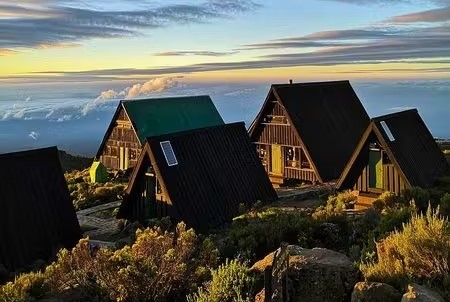
As the only route with huts, many people mistakenly believe that the Marangu route is an easy option.
What are the huts on the Marangu route like?
The hut accomodation are shared, dormitiry style. The huts at Madara (Day 1) and Kibo (Day 4) have 60 bunk beds each.
Horombo has double the capacity as most trekkers spend two nights here. Horombo huts sleep 120 people.
You can expect to find communal dining areas at the huts as well as shared public bathrooms. The lower huts have flushing toilets (unheard of on the other trails!) but as you get higher, this quickly changes to long drops.

Plan your Kilimanjaro trek
Get a quote from my recommended local Kilimanjaro operator
Marangu Route Map
The Marangu route can be completed in 5 days; however, it is recommended that climbers take an extra day to acclimatise at Horombo Hut.
The main setback on the Marangu Route is that the ascent is exactly the same as the descent and therefore there is not as much variety in settings compared to other routes. It also means that the route can get very crowded.
The Marangu Route success rate also tends to be low as it is usually chosen by inexperienced and unprepared trekkers who are misled to believe it is the easiest route on Kilimanjaro. See Kilimanjaro success rates.
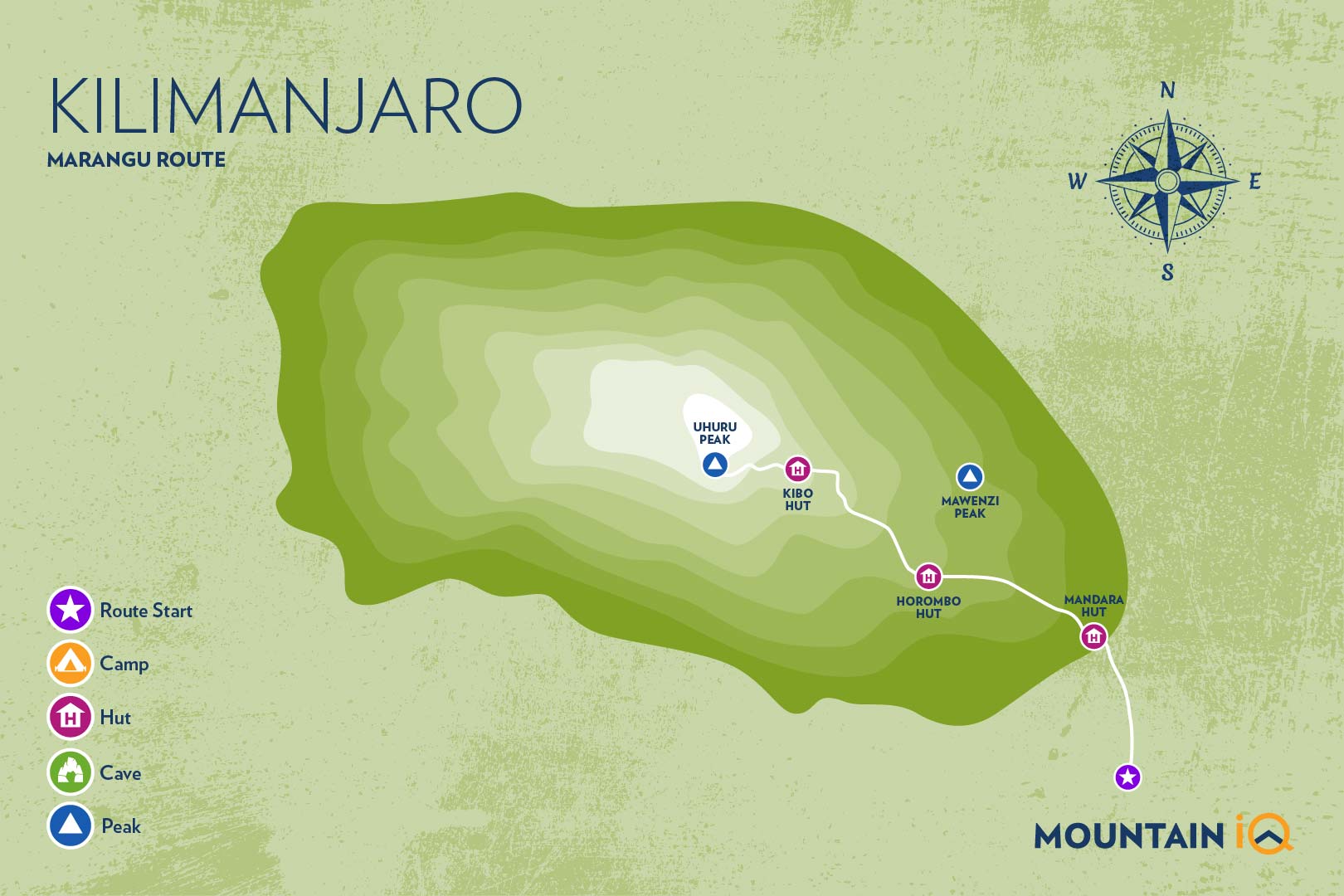
Marangu Route Itinerary
Below is the typical itinerary for an 6-day Marangu Route.
Day 1 – Marangu Gate (1,870 meters) to Mandara Hut (2,700 meters)
Distance: ~8km / 5 miles
Trekking time: 4-6 hours
Zone: Rainforest
The Marangu Route begins at Marangu Gate (1,870 meters) on the South-East side of Mount Kilimanjaro (see map above).
Typically you will be driven to the gate from Moshi, which takes approximately an hour and passes through the village of Marangu.
If approaching from Arusha it takes over two hours to reach Marangu gate.
At the gate you will meet your trekking team, register with the Kilimanjaro National Park authorities and witness porters assembling and weighing packs of gear that they will be carrying up the mountain.
Day one is a gradual trek through the Kilimanjaro rainforest and takes 5-7 hours to complete.
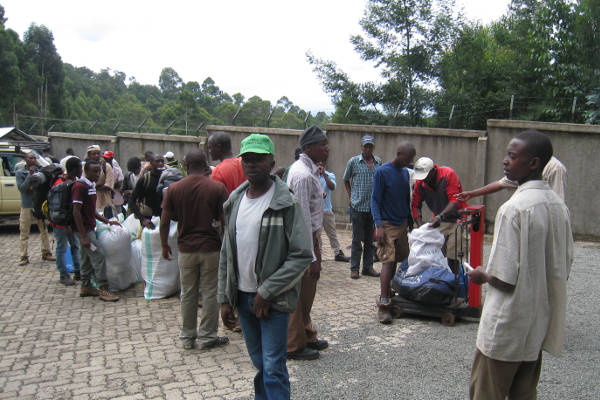
Porters weighing gear
Your first night is spent in the Mandara A-frame Huts (2,700 meters) which come equipped with solar generated lighting, flush toilets and water piped in from a nearby mountain stream.
Each hut has 6-8 bunk beds.
My Pro Tip: If you are a light sleeper we suggest bringing ear plugs!

Plan your Kilimanjaro trek
Get a quote from my recommended local Kilimanjaro operator
Day 2 – Mandara Hut (2,700 meters) to Horombo Hut (3,720 meters)
Distance: ~12km / 7 miles
Trekking time: 6-8 hours
Zone: Rainforest / Low-alpine zone
Day two on the Marangu Route begins with an early start. You will be served breakfast and should be on your way by latest 08:30.
The trek continues through the rainforest, around the base of the Maundi Crater and then transitions rather rapidly into the low alpine moorland zone.
If the weather is clear you should definitely take the opportunity to scramble up the Maundi Crater to get your first full view of Kibo.
During the trek you will also see giant lobelias which are scattered throughout the landscape at this altitude. Day two takes approximately 6-8 hours to complete and covers a significant distance (11.5km / 7miles).
At Horombo Hut (3,720 meters) you will be served dinner and shown to your sleeping quarters for the night.
Day 3 – Acclimatisation Day at Horombo Hut
Distance: 0 km
Trekking time: 0 hours
Zone: Low-alpine zone / High-alpine zone
This is an important acclimatisation day at Horombo. Most tour operators will take hikers on a hike towards Mawenzi.
This is a 3 hour hike up and about 1.5 hours back. I highly recommend it as it will assist with acclimatisation.

Plan your Kilimanjaro trek
Get a quote from my recommended local Kilimanjaro operator
Day 4 – Horombo Hut (3,720 meters) to Kibo Hut (4,700 meters)
Distance: 10 km / 6 miles
Trekking time: 5-7 hours
Zone: Low-alpine zone / High-alpine zone
You will depart from Horombo Hut early and begin a 1,000 meter ascent to Kibo Hut which covers a distance of approximately 10km.
There are two routes to Kibo. The first, or upper route, forks to the right. Six day trekkers would have trekked this route on their acclimatisation day to Mawenzi Hut.
You will most likely take the lower left hand route as it is easier and nearly an hour shorter. On the left hand route you will pass the last water point at 4,130 meters.
My Pro Tip: Make sure to fill up your water reserves here as you will not find another watering point until you get back to Horombo Hut from the summit (you are able to buy bottled mineral water at Kibo Hut).
At Kibo Hut you will be served an early dinner and should try get to bed before 19:00 as you will be awoken around 23:30 to start your 1,150 meter ascent to Uhuru Peak.
My Bonus Pro Tip: Make sure that you have all your gear ready for a prompt departure, including insulated water, snacks, your headlamp and camera.

Hut accommodation on the Marangu Route
Day 5 – Kibo Hut (4,700 meters) to Uhuru Peak (5,895 meters) and then Horombo Hut (3,720 meters)
Distance: ~5.5km / 3 miles ascent and then 15km / 8 mile descent
Trekking time: 6-8 hours to the summit and then 5-8 hours to Horombo Hut
Zone: Glacial zone, high alpine zone and low alpine zone
Day five begins with summit night. After being awoken you will be served some hot tea and biscuits and will then begin your summit ascent.
The route follows a rocky path to the first check point, Hans Meyer Cave at 5,150 meters. It then continues to zigzag for a good 2-3 hours until you get to Gilman’s Point (5,681 meters) on Kibo’s crater rim.
You will most likely be very tired at this point.
Take some time to rest and refuel with a snack. The final push is tough and requires mental stamina. Focus on moving slowly and deliberately for the final 200 meter ascent.
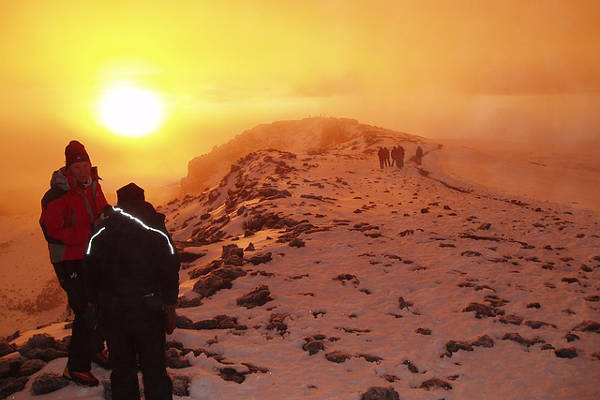
Sunrise, with the summit in the distance. Not far to go now!
At Uhuru Peak (5,895 meters) you will not be able to stay too long so make sure to get all the pictures you want to take and then begin your descent back to Kibo Hut, and onto Horombo Hut.
In total you will be trekking upwards of 12-16 hours. It will be one of the longest days of your life but well worth it! Here’s the good news, beers can be bought at Horombo!
Day 6 – Horombo Hut (3,720 meters) to Marangu Gate (1,870 meters)
Distance: 20 km / 12.5 miles
Trekking time: 6-8 hours
Zone: Low alpine zone and rainforest
Day six from Horombo Hut to Marangu Gate is nearly 20km but usually only takes 7 hours to complete. You will be exhausted at this stage and spend most of the hike imagining the hot shower you will be having that evening.
At Marangu Gate you will be presented with your certificate, either for Gilman’s Point or Uhuru Peak (depending on how far you managed to get).
It is customary to present your support team with their hard-earned tips at this point. You will then be driven back to your hotel where celebrations can begin!

Plan your Kilimanjaro trek
Get a quote from my recommended local Kilimanjaro operator
Kilimanjaro Marangu Route Altitude Profile
Here's what the Kilimanjaro Marangu route altitude profile looks like.
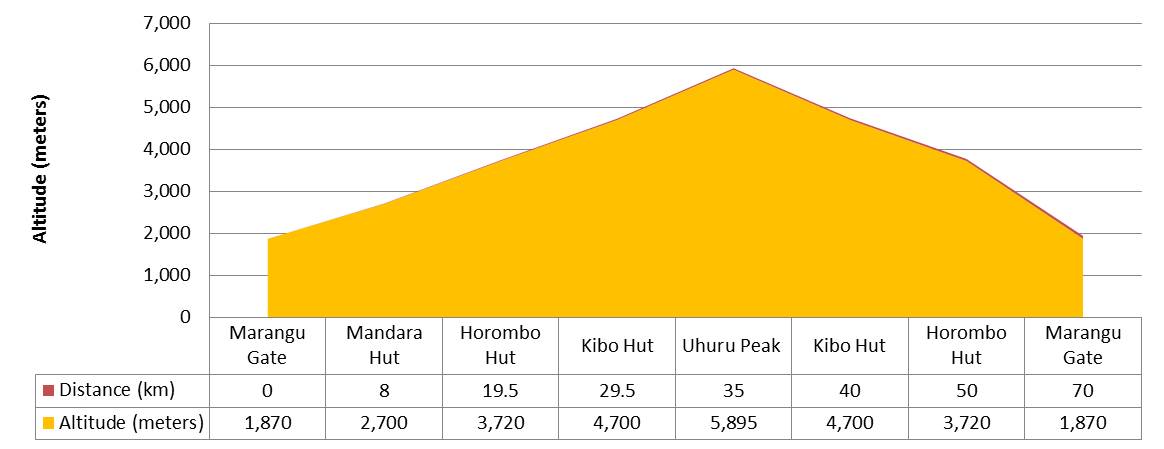
My Fional Thoughts
And there you have it: You're now an expert on the Marangu Route, Mt Kilimanjaro. Feel free to share some of your tips in the comments below. Let's share the love for climbing Kilimanjaro.
Other Kilimanjaro routes and helpful Mount Kilimanjaro trek guides:

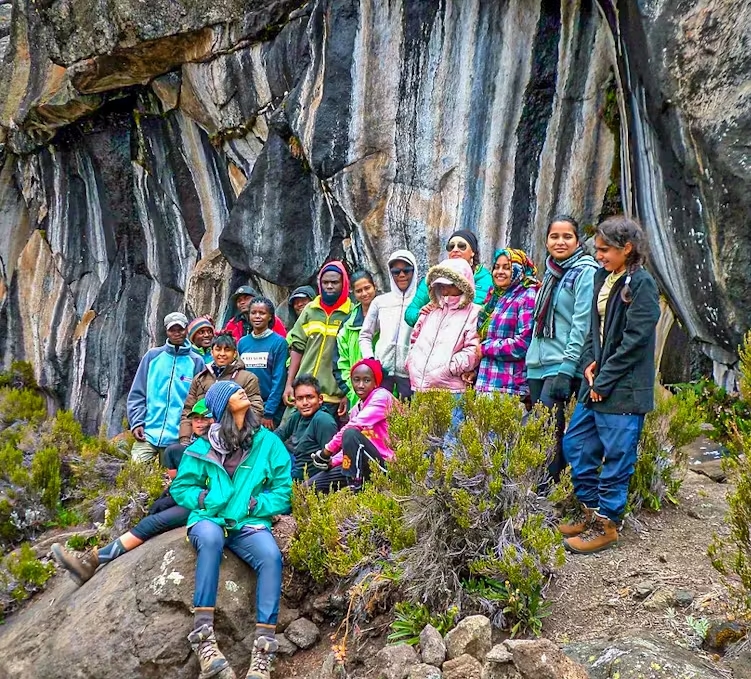
Am so excited to climb mount Kilimanjaro for the first time
Can i climb through this route in 3 days ?
It is possible, but you would need to pre acclimatise otherwise you seriously run the risk of getting altitude sickness.
I am enquiring for my Son Rufus, who is 17 years old, and spends his life outside school bouldering at the climbing centre and is drawn to the mountain/outdoors activity life.
He has been very interested in being part of an exploration / adventure particularly ascending a mountain, such as Kilimanjaro, learning basic mountaineering.
He is fit and sensible and I wondered if his age is an impediment to joining one of your courses or does he need adult accompaniment outside paying for a guide ?
Many thanks
Angus Aagaard
Hi Angus, most operators will require an adult to join minors under 18 years old. I hope your son gets the opportunity to go! All the best!
Hi, What is the success rate from start to finish on the marangu route. If a member of our group can’t complete the trek, do they have to find accommodation or would you supply them. Thank you
Hi John, the Marangu unfortunately has one of the lowest summit success rates as many people take the 5-day option, which isn’t great for acclimatisation. The 6-day Marangu is a better option and has success rates in the high 70s/80s% (estimate). We don’t run treks but generally if someone get’s altitude sickness they will need to descend with a support crew member and will then either wait at one of the lower camps for the rest of the team to return, or if their condition is bad they will be rushed to hospital for treatment.
I have had both my knees replaced and have only about a 50 degree bend in my left knee, will this hinder my attempt on the Marangu 6 day route?
Hi Gary, if you are comfortable hiking 6-8 hours a day for multiple days then you should be fine. Personally I find coming down more challenging on the knees. This is particularly true on Kilimanjaro where the volcanic scree near the top of the mountain is loose and slippery. I highly recommend taking hiking poles. All the best!
It’s a great tour!
Can you recharge electronics at any of the huts?
What was the age and sex of the oldest climer?
Female, 86 years old. Here is more information: https://www.climbkilimanjaroguide.com/angela-vorobeva-become-the-oldest-woman-to-climb-kilimanjaro/
Hello,
I was planning to climb using Marangu route, but as per your report success rate is low. Is it that difficult? I dont want to change my plan
Hi Girija, the Marangu is in fact one of the easier routes on Kilimanjaro in terms of terrain. The reason for the low summit success rate is due to it’s relatively poor acclimatisation profile and the fact that many trekkers opt to do the 5 day Marangu, which doesn’t provide much time to acclimatise. If you are doing the 6 day Marangu then you summit chances are quite high. All the best!
Machame Route is a most challenging and well profile Kilimanjaro route.
do you have one day trek from maranga gates to Mandara Hut and back for 2 people
Hi Bob, some operators will offer a short one day hike. Unfortunately I don’t know any who provide this option though.
Marangu route in 5 days (shot in Feb 2017):
https://youtu.be/p8uixVPK2kg